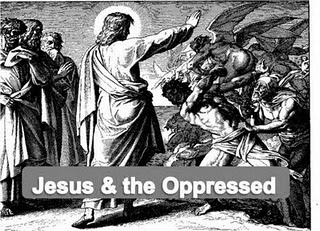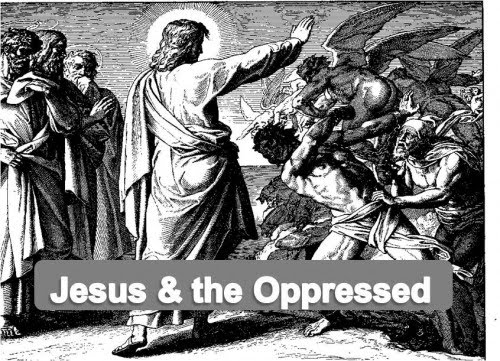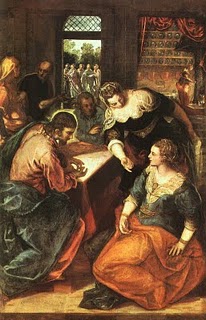
 actively intervenes within the world; not simply making an entrance, but—through His life, death, resurrection, and ascension—actively restoring humanity to Himself. Simeon’s blessing, in Lk 2:29-35, is an allusion to the Septuagint (Is. 49:6) and is being used to verify that the restoration of
actively intervenes within the world; not simply making an entrance, but—through His life, death, resurrection, and ascension—actively restoring humanity to Himself. Simeon’s blessing, in Lk 2:29-35, is an allusion to the Septuagint (Is. 49:6) and is being used to verify that the restoration of Bearing in mind this theme in Luke’s Gospel, it is important to notice the way in which women are given a significant place in the narrative—not just as interesting characters in a story, but as direct participants with Jesus and the disciples and recipients of His abundant, overflowing love. “In the first century, women were kept very much in their place. But Luke sees them as the objects of God’s love and he writes about many of them” (Morris 41). The Gospel illustrates Jesus radically departing typical social conventions while extending God’s mercy to women (Culpepper 24-5). “…[H]e specifically  includes women among those for whom the coming of the kingdom is good news and points to the inauguration of a new community in which freedom, dignity, and equality may be realized” (Culpepper 24-5).
includes women among those for whom the coming of the kingdom is good news and points to the inauguration of a new community in which freedom, dignity, and equality may be realized” (Culpepper 24-5).
Mary and Martha and Jesus (Lk 10:38-422, 3, 4). In this passage, Luke tells of a specific interaction between Mary, Martha, and Jesus and points out the two differing actions of the two women—Martha welcomes Jesus into their home, and Mary sits at Jesus feet while he teaches. An important aspect of this passage is the Greek word that is translated as, “who sat at…”, which not only describes Mary’s actions but also describes her directly—“the one who is at Jesus’ feet.” Mary—as this “one”—sits in the place reserved for disciples. “That a woman has this position is somewhat unusual… Jesus’ ministry breaks molds…” (Bock 1040).
The picture is that of a rabbi instructing his pupil. The extraordinary feature is that the pupil is a woman. Judaism did not forbid women to be instructed in the Torah. But it was very unusual for a rabbi to “lower himself” to this. In the social system of the time women were a ‘rejected’ group, and Luke pays considerable attention to the acceptance which Jesus accords them (Ellis 162).
In Luke 10:39, we have an image of the in-breaking/restoration event for women: Jesus stooping so low to teach Torah to a woman.
As Mary sits, Martha is dutifully fulfilling her culturally assigned role, but too distracted to focus on Jesus, the incarnate Word of God (Culpepper 231). Jesus lovingly addresses her (“Martha, Martha…” v.41), and expresses his concern. Yet, just at the moment when one might expect Jesus to tell Mary to help her sister, He doesn’t. Rather, he subverts the traditional social role (v.42a). The love of God and harkening to his Word trumps everything else. Mary exemplifies what it means to be so enraptured by Jesus and so consumed with His love that her love for Him pours out—not from her own source of love or striving, but in response to the One who is the Source of all love. Mary, in love, can do nothing else but listen to Him and be in His presence—this is the “good portion” (v.42b). She placed herself at His feet, and disregarded the typical role first century Jewish society had carved out for her. Green writes,
What is this ‘one thing,’ this ‘better part’ Mary has chosen? She is fixed on the guest, Jesus, and his word; she heeds the one whose presence is commensurate with the coming of the
Jesus affirms that this choice will not be taken away from Mary (v.42c), and simultaneously affirms Mary’s “radical violation of Palestinian social roles” (Culpepper 232). This is not a one time event.
Sin disrupted humanity’s relationship with God and nature and disrupted the relationship between man and woman (Gen. 3:14-17). The in-breaking of God’s kingdom through Jesus, restored what sin destroyed. Jesus, fully God and fully male, reaches down and grabs the hand of the woman and lifts her up. She is taken out of the subjection to man and returned to his side; and this restoration is sealed with a promise that it “will not be taken away from her.”

COMMENTS
4 responses to “"Hello, Woman. It’s Me, Jesus.": Jesus, Mary, and Martha”
Leave a Reply













1. “…the word is inserted…into the LXX quotation [in Acts 15:16] of Amos 9.11, where it refers to the end-time of restoration of David’s house. J. Jervell argues convincingly that, in the context of James’s speech, Israel’s restoration is assumed to have already been accomplished in the formation of the Jerusalem Christian community and the connection between vv.16 and 17 can be understood only as describing the relationship between Israel and the Gentiles. Thus, the word Luke uses to describe the restoration of the daughter of Abraham [Lk 13:16] is also the word used in Acts 15 to describe the end-time restoration of Israel already begun with the Christian Pentecost” (Hamm 33).
2. “Now as they went on their way, Jesus entered a village. And a woman named Martha welcomed him into her house. And she had a sister called Mary, who sat at the Lord’s feet and listened to his teaching. But Martha was distracted with much serving. And she went up to him and said, ‘Lord, do you not care that my sister has left me to serve alone? Tell her then to help me.’ But the Lord answered her, ‘Martha, Martha, you are anxious and troubled about many things, but one thing is necessary. Mary has chosen the good portion, which will not be taken away from her.’” Luke 10:38-42.
3. The story of Martha and Mary poignantly follows the story of the Good Samaritan. The coupling of the two stories fully and accurately answers the question posed to Jesus by the lawyer in 10:25, “’Teacher, what shall I do to inherit eternal life?’” The story of the Good Samaritan addresses the love of neighbor (Lev. 19:18) and defines who our neighbor is. The Martha and Mary passage addresses what it means to love God with our entire being (Deut 6:1-9). These two stories together develop the complete description of what it means to inherit eternal life.
4. This is a very condensed re-write of a larger exegesis paper on Luke 10:38-42. If there are any questions about the conclusions made in this post, please let me know. Maybe we can find a way to for me to provide you with more information.
Great post, Lauren!
I love your study of this Luke passage. When I have come across it before, I see it very much from a law perspective, that is, typically the lesson that is supposed to be taken away is that Martha did something wrong by being so "task oriented" and not learning from Jesus. I appreciate your consideration that the larger message of this passage is that Christ breaks off traditional societal definitions of what it means to be a woman, without defining what it means to be a woman. Rather than society it is the woman who is able to choose her own definition (is she a Mary or a Martha) in response to living within the presence of God.
How then do we apply this message? If you will allow me to draw a parallel and find that one modernization of sitting at the feet of Jesus takes place at a church (but really, anywhere we are, we are sitting at the feet of Jesus) what is (or should be) the church's position on the role of women in the pews and in ministry? How do we as Christians create an environment that allows women to freely engage in all aspects of ministry that they wish, rather than strictly relegating it to gender roles?
Please excuse my horrible abuse of the English Language in the 2nd sentence of the 2nd paragraph! Obviously, it should read: "Whenever I have come across this passage before, I HAVE seeN…
Very good study. I don't think I have ever seen the text in this fashion.
My simple reading has always been to see one person who is pursuing something that is very good (serving the Lord and other people in a way that is needed) and one person who is pursuing something ultimate.
I think a lot of what we do at church and at home or wherever we serve, is very good and needs to be done. I think the question this passage wants me to ask is “am I pursuing the ultimate thing” either first and foremost or within the framework of something good and necessary. Or am I not pursuing that ultimate thing at all and substituting something good (but yet something that in the end won’t save me).